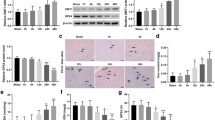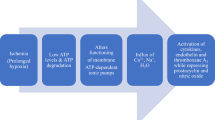Abstract
Ischaemia followed by reperfusion (I/R) can induce inflammation and injury and is a risk factor for delayed graft function and rejection of transplanted kidneys. Inflammation is regulated by NF-κB transcription factors which induce pro-inflammatory molecules in endothelial cells (EC). We examined whether A20, a negative regulator of NF-κB, can protect kidneys from I/R injury. To mimic the fluctuations in endothelial oxygenation that occur during I/R we exposed cultured human umbilical vein EC (HUVEC) to hypoxia (1% O2 for 4 h) followed by re-oxygenation (21% O2 for 1 h–24 h). We observed transient expression of pro-inflammatory molecules (E-selectin, VCAM-1 and IL-8) and sustained expression of A20 in HUVEC exposed to hypoxia/re-oxygenation. The effect of A20 on endothelial responses to hypoxia/re-oxygenation was assessed. We observed that pre-treatment of HUVEC with an adenovirus containing A20 (Ad-A20) suppressed activation of NF-κB and induction of pro-inflammatory molecules by hypoxia/re-oxygenation, whereas a control adenovirus had little or no effect. Thus the induction of A20 may form a negative feedback loop in pro-inflammatory signalling in cells exposed to hypoxia/re-oxygenation. To validate our cell culture experiments we examined the role of A20 in renal responses to I/R. We observed that A20 was induced in rat kidneys exposed to I/R. Moreover, pre-treatment of animals with Ad-A20 significantly reduced acute tubular necrosis, renal expression of VCAM-1 and NF-κB activation in response to I/R, whereas pre-treatment with control adenovirus did not. Our observations suggest that A20 maintains physiological homeostasis in kidneys exposed to I/R by protecting them from inflammation and injury.




Similar content being viewed by others
References
Perico N, Cattaneo D, Sayegh MH, Remuzzi G (2004) Delayed graft function in kidney transplantation. Lancet 364:1814–1827
Gueler F, Gwinner W, Schwarz A, Haller H (2004) Long-term effects of acute ischemia and reperfusion injury. Kidney Int 66:523–527
Shoskes DA, Halloran PF (1996) Delayed graft function in renal transplantation: etiology, management and long-term significance. J Urol 155:1831–1840
Jo SK, Sung SA, Cho WY, Go KJ, Kim HK (2006) Macrophages contribute to the initiation of ischaemic acute renal failure in rats. Nephrol Dial Transplantation 21:1231–1239
Wu HL, Chen G, Wyburn KR, Yin JL, Bertolino P, Eris JM, Alexander SI, Sharland AF, Chadban SJ (2007) TLR4 activation mediates kidney ischemia/reperfusion injury. J Clin Invest 117:2847–2859
Cao CC, Ding XQ, Ou ZL, Liu CF, Li P, Wang L, Zhu CF (2004) In vivo transfection of NF-kappa B decoy oligodeoxynucleotides attenuate renal ischemia/reperfusion injury in rats. Kidney Int 65:834–845
Kokubo S, Takahashi W, Furuichi K, Kobayashi K, Yokoyama H, Mukaida N (2002) Tumor necrosis factor receptor is required for tubulointerstitial injury after ischemia–reperfusion. J Am Soc Nephrol 13:553A
Sung FL, Zhu TY, Au-Yeung KKW, Siow YL, O K (2002) Enhanced MCP-1 expression during ischemia/reperfusion injury is mediated by oxidative stress and NF-kappa B. Kidney Int 62:1160–1170
Donnahoo KK, Shames BD, Harken AH, Meldrum DR (1999) The role of tumor necrosis factor in renal ischemia–reperfusion injury. J Urology 162:196–203
Kol A, Bourcier T, Lichtman AH, Libby P (1999) Chlamydial and human heat shock protein 60s activate human vascular endothelium, smooth muscle cells, and macrophages. J Clin Invest 103:571–577
Li CY, Jackson RM (2002) Reactive species mechanisms of cellular hypoxia–reoxygenation injury. Am J Physiol-Cell Physiol 282:C227–C241
Beyaert R, Heyninck K, Van Huffel S (2000) A20 and A20-binding proteins as cellular inhibitors of nuclear factor-kappa B-dependent gene expression and apoptosis. Biochem Pharmacol 60:1143–1151
Boone DL, Turer EE, Lee EG, Ahmad RC, Wheeler MT, Tsui C, Hurley P, Chien M, Chai S, Hitotsumatsu O, McNally E, Pickart C, Ma A (2004) The ubiquitin-modifying enzyme A20 is required for termination of Toll-like receptor responses. Nature Immunol 5:1052–1060
Lee EG, Boone DL, Chai S, Libby SL, Chien M, Lodolce JP, Ma A (2000) Failure to regulate TNF-induced NF-kappa B and cell death responses in A20-deficient mice. Science 289:2350–2354
Bach FH, Ferran C, Hechenleitner P, Mark W, Koyamada N, Miyatake T, Winkler H, Badrichani A, Candinas D, Hancock WW (1997) Accommodation of vascularized xenografts: expression of “protective genes” by donor endothelial cells in a host Th2 cytokine environment. Nature Med 3:196–204
Kunter U, Floege J, von Jurgensonn AS, Stojanovic T, Merkel S, Grone HJ, Ferran C (2003) Expression of A20 in the vessel wall of rat-kidney allografts correlates with protection from transplant arteriosclerosis. Transplantation 75:3–9
Daniel S, Arvelo MB, Patel VI, Longo CR, Shrikhande G, Shukri T, Mahiou J, Sun DW, Mottley C, Grey ST, Ferran C (2004) A20 protects endothelial cells from TNF-, Fas-, and NK-mediated cell death by inhibiting caspase 8 activation. Blood 104:2376–2384
Grey ST, Longo C, Shukri T, Patel VI, Csizmadia E, Daniel S, Arvelo MB, Tchipashvili V, Ferran C (2003) Genetic engineering of a suboptimal islet graft with A20 preserves beta cell mass and function. J Immunol 170:6250–6256
Kunter U, Daniel S, Arvelo MB, Choi J, Shukri T, Patel VI, Longo CR, Scali ST, Shrikhande G, Rocha E, Czismadia E, Mottley C, Grey ST, Floege J, Ferran C (2005) Combined expression of A1 and A20 achieves optimal protection of renal proximal tubular epithelial cells. Kidney Int 68:1520–1532
Keelan ETM, Licence ST, Peters AM, Binns RM, Haskard DO (1994) Characterization of E-selectin expression in-vivo with use of a radiolabeled monoclonal-antibody. Am J Physiol 266:H279–H290
Thornhill MH, Wellicome SM, Mahiouz DL, Lanchbury JSS, Kyanaung U, Haskard DO (1991) Tumor-necrosis-factor combines with Il-4 or Ifn-gamma to selectively enhance endothelial-cell adhesiveness for t-cells—the contribution of vascular cell-adhesion molecule-1-dependent and molecule-1-independent binding mechanisms. J Immunol 146:592–598
Partridge J, Carlsen H, Enesa K, Chaudhury H, Zakkar M, Luong L, Kinderlerer A, Johns M, Blomhoff R, Mason JC, Haskard DO, Evans PC (2007) Laminar shear stress acts as a switch to regulate divergent functions of NF-kappa B in endothelial cells. FASEB J 21:3553–3561
Evans PC, Taylor ER, Coadwell J, Heyninck K, Beyaert R, Kilshaw PJ (2001) Isolation and characterization of two novel A20-like proteins. Biochem J 357:617–623
Opipari AW, Boguski MS, Dixit VM (1990) The A20 Cdna induced by tumor necrosis factor-alpha encodes a novel type of zinc finger protein. J Biol Chem 265:14705–14708
Ng CKD, Deshpande SS, Irani K, Alevriadou BR (2002) Adhesion of flowing monocytes tohypoxia-reoxygenation-exposed endothelial cells: role of Rac1, ROS, and VCAM-1. Am J Physiol-Cell Physiol 283:C93–C102
Kokura S, Wolf RE, Yoshikawa T, Granger DN, Aw TY (2000) T-lymphocyte-derived tumor necrosis factor exacerbates anoxia-reoxygenation-induced neutrophil-endothelial cell adhesion. Circ Res 86:205–213
Natarajan R, Fisher BJ, Jones DG, Ghosh S, Fowler AA (2002) Reoxygenating microvascular endothelium exhibits temporal dissociation of NF-kappa B and AP-1 activation. Free Rad Biol Med 32:1033–1045
Cummins EP, Berra E, Comerford KM, Ginouves A, Fitzgerald KT, Seeballuck F, Godson C, Nielsen JE, Moynagh P, Pouyssegur J, Taylor CT (2006) Prolyl hydroxylase-1 negatively regulates I kappa B kinase-beta, giving insight into hypoxia-induced NF kappa B activity. Proc Natl Acad Sci USA 103:18154–18159
Rius J, Guma M, Schachtrup C, Akassoglou K, Zinkernagel AS, Nizet V, Johnson RS, Haddad GG, Karin M (2008) NF-kappa B links innate immunity to the hypoxic response through transcriptional regulation of HIF-1 alpha. Nature 453:807–809
Evans PC, Ovaa H, Hamon M, Kilshaw PJ, Hamm S, Bauer S, Ploegh HL, Smith TS (2004) Zinc-finger protein A20, a regulator of inflammation and cell survival, has de-ubiquitinating activity. Biochem J 378:727–734
Wertz IE, O’Rourke KM, Zhou HL, Eby M, Aravind L, Seshagiri S, Wu P, Wiesmann C, Baker R, Boone DL, Ma A, Koonin EV, Dixit VM (2004) De-ubiquitination and ubiquitin ligase domains of A20 downregulate NF-kappa B signalling. Nature 430:694–699
Li Y, Muruve DA, Collins RG, Lee SS, Kubes P (2002) The role of selectins and integrins in adenovirus vector-induced neutrophil recruitment to the liver. Eur J Immunol 32:3443–3452
Li HL, Zhuo ML, Wang D, Wang AB, Cai H, Sun LH, Yang QL, Huang Y, Wei YS, Liu PP, Liu DP, Liang CC (2007) Targeted cardiac overexpression of A20 improves left ventricular performance and reduces compensatory hypertrophy after myocardial infarction. Circulation 115:1885–1894
Shaw J, Eydelnant IA, Kirshenbaum LA (2007) Transgenic expression of A20 prevents cardiac cell death and myocardial dysfunction after myocardial infarction. Circulation 115:1827–1829
Leonard MO, Kieran NE, Howell K, Burne MJ, Varadarajan R, Dhakshinamoorthy S, Porter AG, O’Farrelly C, Rabb H, Taylor CT (2006) Reoxygenation-specific activation of the antioxidant transcription factor Nrf2 mediates cytoprotective gene expression in ischemia-reperfusion injury. FASEB J 20:2624–2626
Ke BB, Shen XD, Tsuchihashi SI, Gao F, Araujo JA, Busuttil RW, Ritter T, Kupiec-Weglinski JW (2007) Viral interleukin-10 gene transfer prevents liver ischemia–reperfusion injury: Toll-like receptor-4 and heme oxygenase-1 signaling in innate and adaptive immunity. Hum Gene Ther 18:355–366
Blydt-Hansen TD, Katori M, Lassman C, Ke B, Coito AJ, Iyer S, Ettenger R, Busuttil RW, Kupiec-Weglinski JW, Buelow R (2003) Gene transfer-induced local heme oxygenase-1 overexpression protects rat kidney transplants from ischemia/reperfusion injury. J Am Soc Nephrol 14:745–754
Liu XL, Pachori AS, Ward CA, Davis JP, Gnecchi M, Kong DL, Zhang LN, Murduck J, Yet SF, Perrella MA, Pratt RE, Dzau VJ, Melo LG (2006) Heme oxygenase-1 (HO-1) inhibits postmyocardial infarct remodeling and restores ventricular function. FASEB J 20:207–216
Rentsch M, Kienle K, Mueller T, Vogel M, Jauch KW, Pullmann K, Obed A, Schlitt HJ, Beham A (2005) Adenoviral bcl-2 transfer improves survival and early graft function after ischemia and reperfusion in rat liver transplantation. Transplantation 80:1461–1467
Acknowledgments
We thank John McDaid (Imperial College London) and Katja Ahrens, Christoph Schmaderer, Marcel Roos and Krisztina Rusai (Technical University of Munich) for technical support. The work was funded by Kidney Research UK and the KKF program of the Medical Faculty of the Technical University of Munich.
Author information
Authors and Affiliations
Corresponding author
Additional information
Jens Lutz and Le A. Luong made equal contributions.
Rights and permissions
About this article
Cite this article
Lutz, J., Luong, L.A., Strobl, M. et al. The A20 gene protects kidneys from ischaemia/reperfusion injury by suppressing pro-inflammatory activation. J Mol Med 86, 1329–1339 (2008). https://doi.org/10.1007/s00109-008-0405-4
Received:
Revised:
Accepted:
Published:
Issue Date:
DOI: https://doi.org/10.1007/s00109-008-0405-4




